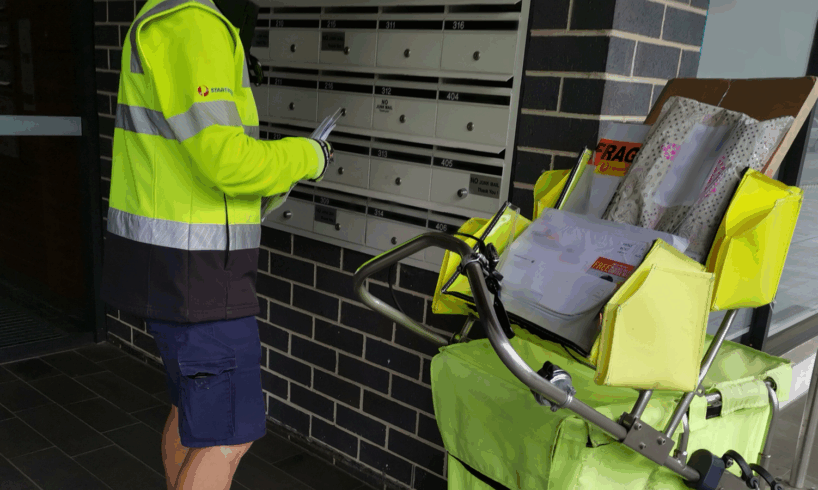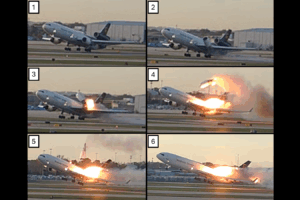
Announcing the company’s annual financial results in late August, Australia Post (AP) CEO Paul Graham made clear that ongoing restructuring measures will be expanded and deepened, as the state-owned postal service is rapidly transformed into a parcel delivery business.
Australia Post worker delivers mail in Sydney
Despite record-high revenue of $9.45 billion, AP made only a “modest” pre-tax profit of $18.8 million. Graham attributed this primarily to a supposed $230.4 million loss by the letters side of the business, which recorded an 11.7 percent decline in volume.
He said: “We’ve passed the tipping point… we are primarily a parcels business that also provides a loss-making letters service.” To avoid “becoming a drain on the taxpayer,” AP will need to “simplify and transform” its operation.
Graham’s comments should be a warning to all AP workers: Last year’s halving of letter delivery frequency to every second day was only the beginning. AP management, with the backing of the federal Labor government and the Communication Workers Union (CWU) bureaucracy, is working towards eliminating letters entirely and transforming the company into a profit-focussed parcel delivery business.
This will have enormous consequences for postal workers. The daily delivery of letters to every address in the country has for decades been carried out largely by full-time workers, with relatively stable and secure jobs.
In the parcel delivery business, however, AP will increasingly be competing with “gig-economy” operations like Amazon Flex and Uber. At recent meetings, under the banner of “Our AP Way,” management told workers the company is at “war” with its competitors.
For workers, such a “war” means a race to the bottom on wages and conditions with some of the most notorious exploiters of labour in the advanced capitalist world.
At Amazon Flex, for example, drivers bid online for blocks, typically of four hours, for which they are paid as little as $118. For Uber drivers, there is no minimum hourly pay and time and distance rates are determined by an inscrutable algorithm. In both cases, as “independent contractors,” using their own vehicles, workers have to cover all their expenses, including fuel, parking, maintenance, registration and insurance.
These operations run from the early hours of the morning until late at night, seven days a week. Staffing levels are continuously calculated to precisely match demand. AP’s plans to profitably compete in this increasingly crowded field will mean a complete transformation of working conditions for postal workers. Management is already hinting at the introduction of afternoon shifts, signalling the beginning of this change.
Similar processes of “Amazonification,” the gutting of jobs, wages and conditions, and preparations for privatisation are already far advanced in postal services around the world.
Pointing to these global “challenges,” Graham noted, “The United States, Canada, France, Spain and the United Kingdom are recent examples of postal operators experiencing significant losses, change of ownership, or receiving billion-dollar government-funded bailouts to survive. This is not a path we want to take.”
The alternative path Graham is proposing is to shortcut the process, skip over the “significant losses” and proceed directly to implementing the same sweeping restructuring measures that are being carried out internationally. The introduction of the New Delivery Model (NDM) and alternate-day delivery, along with other cost-slashing measures, such as the closure of post offices, are just the first steps along this path.
While AP management continually complains about the losses in its letters delivery business and blames it for dragging down its profit margins, it has gone on a spending spree “modernising” for parcel delivery. The company spent $371.9 million in the past 12 months on new parcel processing facilities, including the implementation of new AI technology, along with an additional fleet, including 563 new Electric Delivery Vehicles (EDVs) capable of carrying many more parcels than older models.
In order to fight the attack on jobs, wages and conditions at AP, workers first need to understand that management’s restructuring plans are being executed with the complete support of the union bureaucracy.
Speaking to delegates in May, Communications Workers Union (CWU) Central Branch secretary Shane Murphy said: “While other postal services around the world are slashing and burning through their service offerings, privatising their operations and hacking away at their workforce and their pay packets—we’ve achieved the complete opposite.”
In fact, the CWU bureaucracy collaborated with management and the federal Labor government to deliver the biggest “slashing and burning” of AP’s “service offering” in its history—the ending of everyday delivery. The sole purpose of this is to enable the ongoing commercial viability of AP as a parcel business—a necessary prerequisite for privatisation.
The CWU leadership was intimately involved in the design of the NDM, working with management to devise a model that nominally fit within the parameters of “one beat, one postie”—that is, that one delivery worker covers the same route each day. This was necessary because of lingering opposition to the disastrous union-management Alternative Delivery Model (ADM), AP’s previous attempt to slash costs by assigning posties two beats to deliver on alternate days. The ADM was ultimately abandoned because it did not deliver what big business demanded—a low-cost parcel service with delivery times that could compete with Amazon.
The reality of the NDM is that posties are being called upon to deliver more, bigger and heavier, parcels, significantly increasing the workload. While letters are only delivered to half of the beat each day, parcels are delivered to the entire round, an essential component of AP’s transformation.
Having suppressed workers’ opposition to the ADM in 2020 with a no-strike deal, the CWU bureaucracy last year used a 4 percent per annum pay rise offer as a sweetener to lock workers in to the NDM and further restructuring measures to come. While barely higher than the official inflation rate and totally inadequate to make up for the rising cost of living, CWU officials emphasised that it was more than what many other sections of workers were being offered. Most notably, this included virtually the entire public sector, the immediate targets of the wage offensive spearheaded by state and federal Labor governments.
Internationally, postal workers trying to fight attacks on their jobs, wages and conditions are coming into conflict with union bureaucracies that are trying to suppress their struggle and enforce management and government restructuring plans.
On September 25, 55,000 Canadian postal workers walked off the job in opposition to the government’s “Transformation Plan” to eliminate postal delivery as a public service and destroy tens of thousands of jobs. This includes plans to privatise the most profitable sections of Canada Post and sell it off to the highest bidder.
The ongoing strike wasn’t called by the Canadian Union of Postal Workers (CUPW), but started when workers spontaneously walked off the job after hearing of the government’s plans to destroy the postal service. The CUPW bureaucracy is now working overtime to take control of the strike, prevent it spreading to other sections of workers and engineer a return-to-work on the government’s terms.
The developments at Canada Post, as well as the CWU’s complicity in the ADM and the NDM, highlight that the CUPW, like the CWU in Australia, and all other unions, does not represent the interests of workers, but those of big business and the so-called “national” economy.
This means postal workers need to build their own organisations of struggle—rank-and-file committees run by workers themselves, not highly paid union bureaucrats—in every AP depot.
The Postal Workers Rank-and-File Committee (PWRFC) was formed by a group of AP workers in 2021 to fight for this perspective and take forward the struggle against the ongoing restructuring operation, in opposition to the complicit CWU bureaucracy. We encourage all postal and delivery workers, whether at AP or elsewhere, to contact us today to discuss building a rank-and-file committee at your facility and how you can join this fight.
Through such committees, workers can fight for demands based on their needs, not what management, government or the union declares is compatible with “economic headwinds.”
Vast billions are readily available for weapons of mass destruction like the AUKUS nuclear-powered submarines the Labor government has committed to purchase. But when it comes to workers’ wages, living standards, health and education, or a decent postal service, there is supposedly not a cent to spare.
The struggle for postal workers’ jobs, wages and conditions must be connected with a fight against privatisation. The insistence that essential public services, including the post, must be operated as profit-making enterprises should be rejected entirely.
Postal workers cannot fight alone. Through the International Workers Alliance of Rank‑and‑File Committees, they can link up with workers all over the world to build a unified counter-offensive. The objective basis for such a global struggle is rapidly developing. Postal workers, and indeed the entire working class, around the world confront a common assault—not just on jobs and wages, but on the right to strike and other basic democratic rights, with the aim of enforcing the interests of the capitalist oligarchy through dictatorship.
Defeating this will require a fight for a new political perspective that rejects the dominance of corporate profit interests over every aspect of society. This means taking up the struggle for a workers’ government and a socialist program. Australia Post must be placed under full public ownership and democratic workers’ control, along with the banks and major corporations.
Postal workers: Make your voice heard! Tell us about conditions in your workplace





